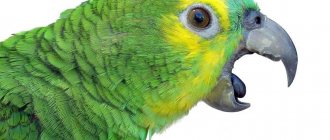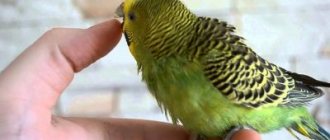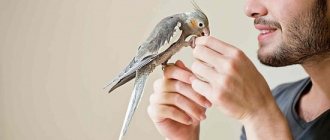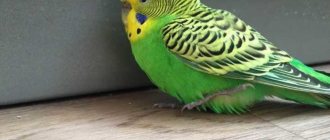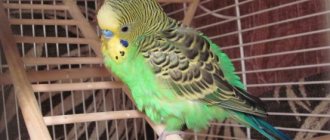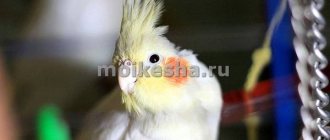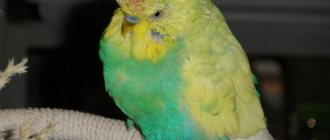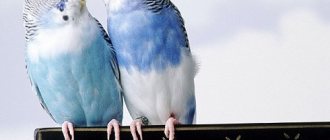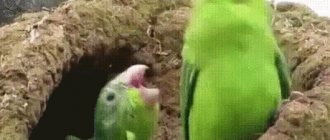Zoya Zorina, Anna Smirnova, Tatyana Obozova “Nature” No. 10, 2018
About the authors
| Zoya Alexandrovna Zorina — Doctor of Biological Sciences, Head of the Laboratory of Physiology and Genetics of Behavior of the Department of Higher Nervous Activity, Faculty of Biology, Moscow State University. M. V. Lomonosov. Scientific interests - elementary thinking of animals, including the ability to generalize and symbolize in corvid birds. |
| Anna Anatolyevna Smirnova — Candidate of Biological Sciences, leading researcher at the same laboratory. Scientific interests: higher cognitive functions of animals as evolutionary prerequisites for human thinking. |
| Tatyana Anatolyevna Obozova — Candidate of Biological Sciences, leading researcher at the same laboratory. Area of scientific interests: elementary thinking of animals, behavior of birds in nature. |
Stories about parrots that “know what they're talking about” occupy a special place among the testimonies of the amazing abilities of animals. An extensive literature is devoted to this topic [], however, as its analysis shows, most often we are talking about a mechanical repetition of memorized phrases, a kind of verbal flow that is completely unrelated to a specific situation. In some cases, the observer may have the illusion of meaningful behavior (for example, the parrot says hello or goodbye in accordance with the situation), but upon closer analysis it turns out that the owner was wishful thinking. And yet, facts gradually accumulated that deserved serious attention: the statements of some talking parrots really were exactly “in place”, the birds uttered completely new words and entire phrases that corresponded to the context. Moreover, their behavior could not be the result of a random coincidence or a simple repetition of the “passed”, since the circumstances had not been noted previously. Reports of such episodes appear infrequently, but regularly, however, since they are isolated, they cannot be verified.
For example, here is one remarkable story. As you know, many (though not all) birds do not talk in front of strangers. Therefore, demonstrating the eloquence of a parrot at the right moment for the owner is a difficult task and not always rewarding. A certain film crew faced this difficulty: the cameramen spent the whole day in the apartment of the owner of talking birds, who did not utter a word the entire time. When they began to assemble the equipment, one of the annoyed guests tripped over the cable. Immediately there was a friendly bird laugh, and one of the parrots shouted: “Yeah, I’m confused!” There was no trace of any preliminary training here - the bird clearly figured out what to say in this unusual collision. Other examples can be given that indicate that in many cases (although by no means in all) the statements of parrots are meaningful - they find and pronounce exactly those words that are appropriate in the situation that has just arisen. And such behavior is usually regarded as a manifestation of the intelligence of animals, albeit elementary.
A convincing answer to the question “do parrots understand what they are talking about” is of fundamental, and not at all particular, importance, since it is directly related to one of the most important tasks of modern cognitive science - the study of the evolutionary preconditions of human thinking. The class of birds developed in the process of evolution in a special way, in parallel with mammals and completely independently of them, however, it has been established that the rudiments of thinking are also present in its representatives [, ]. Higher representatives of the class of birds can make and use tools [, ], they exhibit elements of abstract thinking (formation of preverbal concepts and inferences) [6–9]. Finally, corvids have shown the ability to symbolize, an operation that underlies human language []. The entire range of their cognitive abilities is close to that described in apes [].
The utterances that seem to make sense tend to come from large parrots, mainly African gray parrots ( Psittacus erithacus
)
.
And it was thanks to a representative of this species, the parrot Alex, that a convincing (and, moreover, positive) answer to that very question was received. This happened thanks to, without exaggeration, the heroic research that American psychologist Irene Pepperberg conducted for 30 years (1978–2007) and continues to this day.
Why does the parrot scream
In natural conditions, birds are very active: they look for food, go to watering places, exchange news and, naturally, scream in the morning and before sunset. Their domestic relatives, for the most part, do the same, especially if their owners regulate their daylight hours.
But natural instincts do not always dictate behavior. There are several reasons why a parrot screams:
- the bird reacts to the chirping of birds outside the window. The sounds he makes at the same time are similar to a call, he is trying to shout out to them;
- the pet is afraid of you - this is more typical of wild, untamed birds, although often a seemingly tame parrot in a pet store begins to scream when you, having brought it home, approach the cage. He can scream even at night, frightened by the headlights or noise outside the window;
Important! When afraid, your parrot may scream in an attempt to scare you away and force you to stay away from it. This is where patient taming your pet will help you. Gradually the bird will stop screaming, frightened by any movement, noise and your approach.
- a bird may be afraid or indignant when it sees a cat, dog, or stranger next to it - in this case, it expresses its displeasure or fear by screaming;
- Often, with a loud voice, a pet can signal that it is hungry. Check if there is food in the feeders and if you gave him greens and vegetables today;
- Many birds demand to be let out of the cage for a walk in this way;
- Often birds are jealous of their beloved owners of other household members and by screaming they try to win attention or intimidate a rival;
- There are also parrots that scream loudly, knowing that the owner is about to leave on business, leaving him alone. These are very social birds, they feel deeply sad when no one is with them.
Attention! Don't make your pet suffer from loneliness. If you don’t have time to exercise and communicate with him, or don’t get a parrot at all, or find a solution to the problem: at a minimum, leave the radio or TV on, or at the maximum, get him a mate.
If the parrot screams and screams, although there is no reason for this (there is food in the feeders, toys in the cage, the bird is often outside the cage and is not deprived of your attention), it is quite possible that the pet is in pain, you should contact a veterinary clinic .
Ara parrot
And today everyone knows and loves the fairy tale film “The Kingdom of Crooked Mirrors” made more than half a century ago. The adventures of Olya and her mirror image Yalo in the kingdom of YagupoP 77 (Parrot) will not leave you indifferent. And who else if not Parrot to make king? And, judging by the coloring, this is the Ara parrot - the largest and most beautiful among its relatives. In the film, he is a bright, rather stupid character. Only in real life, real parrots compare favorably with the movie hero - they are not only a bright, unusually beautiful bird, they are the smartest creatures that, living next to a person, force them to reckon with themselves!
https://www.everystockphoto.com/
Let's get acquainted
Macaws are large representatives of the order of parrots, weighing up to two kilograms and being half a meter tall! The wedge-shaped tail is longer than the body, the wings reach forty centimeters. The beak is flattened on the sides, high, rounded downwards, very strong and strong. The plumage is bright, motley with multi-colored tints - the bird itself brings a holiday to the house by its very appearance. At the same time, it is almost impossible to distinguish a male from a female or a young parrot from an old one by plumage. A distinctive feature of the macaw is the absence of feathers around the eyes and on the sides of the head. The skin in these areas can “tell” about the bird’s mood: reddened skin around the eyes indicates a bad mood.
The macaw can safely be considered a long-livers - on average 50-80 years, which should be taken into account if you want to purchase a bird - this is, one might say, a companion for life. It is distinguished by striking beauty and intelligence. There are about 15 subspecies of these parrots.
https://www.everystockphoto.com/
Habitat in nature
Homeland - forests of South and Central America. There are fewer and fewer of these large birds left in nature: not only are humans destroying their usual habitat, but more and more of them are being hunted for commercial purposes from year to year. The price of some species reaches 20 thousand dollars per individual.
In nature, parrots lead a gregarious lifestyle, but they can also live in families or in pairs. The devotion of these birds can be envied: being monogamous by nature, they experience the loss of their soul mate very hard. It happens that for many days a bird stays near a dead friend, which is what hunters use for live goods.
When the mating season begins, the couple builds a nest in the hollow of a favorite tree. There are usually 3 eggs in a clutch, incubation lasts a month, after which the hatchlings are raised for another 3 months. Even when they become quite independent, young birds remain near their parents for a long time. Macaws do not breed annually, and the possible death of chicks and deterioration of living conditions lead to a decline in the natural population.
https://www.everystockphoto.com/
Captivity
Macaws are often kept at home and quickly adapt to life near humans. Birds have been tamed by indigenous people since ancient times, and in Europe the first blue-and-yellow macaw appeared in the 18th century. Today, large multi-colored macaws are the most popular for home keeping.
Having decided to purchase an exotic pet, you need to think about providing it with comfortable living conditions: a large bird needs space and it is simply impossible to keep it in a small cage. You will need either a large all-metal cage (the bird must be able to spread its wings without clinging to the walls of the cage) or an aviary, which will be the optimal solution.
If the macaw is kept in normal conditions with proper feeding and proper care, then practically no communication problems arise. When treated kindly, the Macaw quickly gets used to its owner and becomes tame. But you shouldn’t anger your ward - he becomes aggressive and can become unsafe for others.
Birds, like most pets, require time and attention - at least two to three hours a day. If you do not devote enough time to communication, he may begin to pluck himself or scream heart-rendingly in order to somehow attract attention to his person. It should be taken into account that the sound of a Macaw parrot can be compared in decibels to a car alarm, and if you have thin walls, your neighbors will not be bored. When kept in a cage, it is imperative to let your ward out to “stretch its wings” a couple of times a day.
https://www.everystockphoto.com/
Difficult character
It cannot be said that macaws have an “angelic” character - it is better to resolve all issues with them peacefully. They react to any manifestation of aggression, screaming, in a mirror image. In addition, sometimes they can be jealous not only of other pets, but even of children, so you should not leave children and other animals alone with this large, confident bird, unless the macaw is sitting in a cage. Neighborhood with representatives of other species of parrots is tolerable outside the breeding season; A macaw can easily kill individuals smaller than itself.
Your charge will prove its dominance by clicking its powerful beak, taking off and provocatively frightening it by flying over your head. All these actions must be stopped at the beginning of acquaintance with the bird. The Aru parrot needs to be trained, or you will be trained. Do not provoke the bird to taste your fingers - stay away from the beak. In the early morning and late evening, the macaw is characterized by “chanting” - screams can be heard far beyond the boundaries of the room where it lives.
In general, representatives of this species have an accommodating character (just don’t tease), and a rather playful character. It is distinguished by its courage and high bird intelligence. He loves to dance and talk, which makes him a great circus performer! He remembers words and phrases easily, pronounces them quite clearly, can sing songs and generally imitate almost any sound.
Education and training
Without company, the macaw begins to mope and tries to attract attention. He has a very good memory (there is a known case when a parrot was the only witness to a crime and with its behavior helped the police identify the criminal) and he remembers for a long time those who offended or frightened him. When communicating with a bird, you need to be careful and affectionate, then training will be easy.
Young birds can pinch and even bite, but you should not rush to punish them - this can make matters worse. If a macaw is afraid of someone, it will try to bite and, given the strength and power of its beak, the injury will be quite serious. If a macaw screams, do not shout at it or try to appease it with a toy. In response to a scream, he will scream even louder, and he will regard the toy as a reward and next time he will do the same: he will scream until he is “rewarded.” The best thing is to ignore all his cries and only after the parrot has calmed down, communicate with him.
Macaws are active and playful creatures. Great fans of swinging on ropes and swings; hang upside down; jump and “tumble”, that is, he requires constant exercise, and, in addition to physical, and mental. The macaw can be called an intellectual among the representatives of the parrot genus. Offer your pet different toys - from scrap materials or purchased in a store. These can be boxes, paper bags, tree branches, or you can buy toys for parrots in the Zoo Idea online store. Please note when purchasing – products are only suitable for large species! Do not use the same toys for a long time - replace and clean them at least once a week. The parrot must get used to the toy, he must realize what it is, otherwise he will regard it as a danger. If you are just preparing to acquire a feathered friend, initially, purchase a cage, prepare the home completely and place all the toys, and only then fly the parrot.
Diet
Pets often get food from the owner's table. But if you don’t want problems, then it is better to feed your charges food suitable for their digestion. This fully applies to the macaw, whose diet should contain grain mixtures and fruits and vegetables in a 50/50% ratio.
For large species of parrots, specially balanced food is produced that meets all the needs of the bird. You can buy food for large parrots in the Zoo Idea store. You can create a menu for your pet yourself, you just need a little more time and certain knowledge.
What is possible?
You can offer your Ara parrot almost all types of nuts, sunflower seeds, canary seeds, buckwheat, oats, and wheat. Before “serving” peanuts or Brazil nuts, they must be peeled and washed. You can give melon, pears, peach and nectarine, apricots, apple, banana, plum, cherry, bananas, mango, kiwi, pineapple, papaya, pomegranate, grapes, raspberries, blackberries, red currants, rowan, rose hips. Citrus fruits should be given in limited quantities.
Vegetables should also be present on the table: milky ripe corn, cucumbers, carrots, cauliflower, broccoli (no more than twice a week), kohlrabi, red pepper, chili pepper. Green beans and sweet potatoes should be boiled.
Greens will also help replenish your supply of vitamins and microelements: tree shoots, grain sprouts, dandelion leaves, spinach, plantain, dill and celery.
In addition, you can pamper the Macaw with yogurt (in limited quantities), a boiled egg or a piece of meat, and white bread croutons. You can also offer insects, but not many. Porridge will be a treat for your pet, and apricot kernels are especially popular. You can also buy treats for your parrot in our store.
By volume, the feed should be approximately 10-12% of the bird’s weight. Adults should be fed once or twice a day. The first time is early in the morning, at 5-6 o’clock.
Prohibited!
Coffee and chocolate, avocado and parsley, alcohol and lactic acid products (with the exception of yogurt), salt and sugar, everything fried. The content of nuts is low and the bird gets fat from them.
Be sure to always ensure there is fresh, clean water in the drinking bowl. Choose a heavy, stable drinking bowl - this will be more reliable. Basically, large cages are equipped with metal feeders (only metal, everything else will be destroyed); in addition, in the online store zooidea.ru you can purchase feeders with hooks and screws for cages.
The diet during the breeding season should include cottage cheese (calcium is needed), boiled eggs and chicken meat, insects and white bread.
Even the highest quality feeds and products do not guarantee the provision of the necessary minerals and vitamins, so it is necessary to introduce supplements into the diet - multivitamin and mineral complexes, cuttlefish shell, mineral stone for large birds. At Zoo Idea you can buy vitamins and minerals for parrots.
Reproduction in captivity
If you have a pair of birds, then they may well give birth to offspring, but in this case you need to know how to behave. From April it is better to separate the pair from other birds (if there are any) or simply disturb them less. During the mating season, Macaws are aggressive and even a loved one is not immune from attack.
You should not be curious and climb into the nest box: alarmed birds will destroy the clutch or already hatched chicks. You can inspect it in the morning, when the mother goes to have breakfast (remember - 5-6 hours?).
The nest box is made of hard rock, dimensions 0.3 x 0.3 x 0.9 m or 0.6 x 0.6 x 1.2 m, the cross-section of the entrance is about 17 cm. The bottom is covered with peat, wood dust, and shavings. To maintain a sufficiently high humidity, from time to time it is necessary to spray the walls of the house with water. It happens that not all eggs are fertilized; incubation lasts within 25-30 days.
Diseases
Chicks with excessive humidity may experience convulsions, and with a lack of calcium, improper bone development and beak curvature may occur. Infections of various origins are possible - fungus, pathogens and viruses. Birds are predisposed to enlargement of the stomach, feather pulling, gout, pancreatitis, papillomas and chlamydia. If you encounter lice eaters, peri-eaters or other skin parasites (self-plucking will be a sign), then you can resort to the Bionix, Frontline spray, which has bactericidal and wound-healing properties. The drugs “Arpalit” and “Arpalit neo” will also help fight the disease, but it is better to consult a specialist.
Proper maintenance and balanced nutrition will help you avoid many diseases. If you notice that the bird is unwell, you should rush to the veterinary hospital with an ornithologist on staff.
Housing issue
If you decide to buy a cage for a macaw, it should be a strong metal structure with horizontal rods and a retractable bottom for easy cleaning. It’s still better to buy an aviary for macaws - they need freedom of movement. But in any case, a prerequisite is a reliable lock that cannot be opened from the inside. Models from well-known manufacturers Triol, Tifanny and Ferplast are widely represented in the ZooIdea store. It is better to supplement the lock with a special carabiner.
The minimum parameters of the cage are 0.9x0.9x1.5m; enclosure – 8x3x2m with an adjacent shelter 2x2x3m. Do not install the cage on the floor - it must be located at a height of 0.5-1.2 m. At least two perches at different levels are also necessary. One should be placed close to the feeder and drinker, but not directly above them. It is necessary that there are always twigs in the home for gnawing fruit species.
To maintain good physical shape, in addition to toys, you will need swings, ropes, rings and other accessories for parrots. Macaws need a bath - they bathe with pleasure; it’s good to give them a “shower” with a spray bottle.
The cage should be cleaned daily, and the feeders should also be cleaned every day and the drinking bowl should be washed, changing the water. If a cage is used, disinfection is carried out weekly, and in an enclosure - monthly. Replace perches, drinking bowls and toys as they wear out and fail.
There is no need to invent anything additional for lighting - natural is enough. Temperature – maintain +22+27 C. Maintain humidity within 30-50%.
You can't do without a perch!
Not a single representative of the feathered brethren can do without a perch. This is also an important detail for the macaw. Plastic perches, if included, throw them away immediately! Buy wooden perches or make them yourself - it won’t be difficult. The perch is necessary for grinding down the claws, for cleaning and “sharpening” the beak. Branches for the perch should be harvested as far as possible from the road, preferably in a forest or park.
You should not take coniferous branches - the presence of resin in them will have an adverse effect on your pet. Bird cherry and oak contain a lot of tannins, and lilac can even become poisonous for birds. Poplar shoots are also not suitable, as they absorb harmful substances in the air and soil too well.
Birch, linden, aspen, willow, rowan, plum, apple, cherry, elderberry, beech, hornbeam, alder, and currant are perfect for making perches and for feeding a parrot. If you make the perch yourself, then its diameter should be such that the bird covers 2/3 of it.
The new perch needs to be thoroughly washed in soapy water and doused with boiling water. You don't have to peel off the bark. Replace perches as needed.
Instead of a conclusion
You should think about how much you need the bird and whether you can offer it normal conditions, because:
— macaws are large, strong birds that require space;
- long-livers can live for a century - will you be able to take care of your pet for a long time (“we are responsible for those we have tamed” - remember?);
- Every day Ara needs to be released from the cage - can you keep an eye on him?
- the bird is loud - what will be the reaction of household members and neighbors to the screams?
- you need to pay enough attention - do you have enough time to educate, train and play with your ward?
- calculate your finances
- all the wallpaper around the cage will be covered in berry juice, feathers and fluff will fly all over the house and you won’t wake up to the nightingale singing)
If the issues can be resolved, then go to the nursery - it is better to buy parrots there, it will be more reliable. They will sell you a bird that has been examined by a veterinarian, which will not complicate your life, but on the contrary, will fill it with new meaning!
You can read about the correct acquisition of birds and animals in the following article.
The most screaming parrots: how different species scream
Before you get a pet, you should consider your options. In particular, how will your neighbors or relatives react to noisy birds. Moreover, there are breeds that are particularly loud.
Macaws are not only the loudest screaming birds, but also require special conditions of detention. It is not easy to keep them in a cage, as there is always a risk of damaging the beautiful plumage of the long tail and wings. In addition, with their powerful beaks, these birds love to chew on everything. Listen to how a macaw parrot can scream and think whether you will be able to listen to this “music” for many decades:
Solar aratings are much smaller in size than macaws, but they are not inferior in volume. The calls of these parrots can be heard at a distance of two or more kilometers. Don't believe me? Listen for yourself:
The cockatoo is another screaming parrot. Its advantages: graceful beauty, amazing artistry, affection and immense affection for its owner. But their shrill screams can drive sensitive people crazy. Listen to the cockatoo parrot scream:
Amazons are very loud, but their strong advantage is their excellent ability to reproduce human speech. They easily grasp words and sounds, so it is better to watch what you say so that one fine day your pet does not surprise your guests and yourself with a rich vocabulary.
The necklace parrot , despite its medium size, can scream very loudly and shrilly. Moreover, it is rather an ear-piercing screech with which he tries to shout over everyone. It is his voice that is the most recognizable in the vastness of South Asia:
The African gray parrot is popular for its onomatopoeic ability. These birds perfectly remember words and entire phrases, a wide variety of sounds. The most amazing thing is that sometimes it seems that they understand what they are talking to you about. However, few people know that these parrots can scream very loudly:
Cockatiels are not the quietest parrots. They make sharp, monotonous sounds - this is when the birds are in a good mood, but if something does not suit them and they decide to scream, then the scream will be loud. They also know how to be funny and indignant, judge for yourself:
Lovebirds are beautiful, cheerful and sociable birds that also don’t mind making noise, although the sounds they make are not screams, but a piercing, ringing chirping that feels sharp and sharp:
Budgerigars are also quite noisy birds. Due to their small size, they may not be as “loud” as larger species of birds, but their chirping does not always bring pleasure to their owners. These nimble birds can scream for any reason and in different ways:
- when they are dissatisfied with something or quarrel with their brothers, they make abrupt, sharp sounds;
- when they are bored, try to attract attention, want to leave the cage or ask for food, they chirp abruptly;
- the male attracts the female by singing and clicking;
- when they communicate with each other or are glad to see you, they chirp melodiously;
- They are excited about something, they are afraid - they scream for a long time.
Reasons for Low Expectations for Bird Intelligence
A large place in the monograph Alex and me
devoted to evidence of the high intellectual level of parrots, which is especially valuable for the domestic reader. Indeed, this is practically the first book in Russian entirely devoted to the thinking of birds. The paradox is that the problem of the thinking of animals in general [15–17], and birds in particular, has been actively developed in our country for a whole century. Fundamental research by L.V. Krushinsky [] and his scientific school dedicated to corvids began in the 1950s and continues to the present day [6–11], far ahead of the corresponding work in the West. But it is impossible not to mention that abroad this area of cognitive science is today experiencing rapid growth and is making up for lost time.
Of course, the main thing in Pepperberg's book is proof that parrots can speak meaningfully, that they can actually understand words, both their own and those spoken by their interlocutor. In this regard, the author touches on a number of major scientific problems related to birds.
The main one is due to the characteristics of the bird’s brain, which in its structure is radically different from the brain of mammals. Due to the absence of a neocortex, researchers were inclined to consider it primitive (“an overgrown subcortex”), and the cognitive abilities of birds were obviously limited, despite numerous manifestations of their intelligence both in experiments and in spontaneous behavior. This paradox was explained relatively recently, when data were obtained on the homology of the higher parts of the avian brain (hyperpallium and nidopallium) and the neocortex of mammals. A number of evidence of this were received after the release of Alex and me
[], and we presented this data in the preface to the Russian translation of the book [].
The monograph “Alex and Me” is also interesting because it takes us back to the atmosphere of the 1970s, when Pepperberg (trained as a theoretical chemist) decided to study the thinking of birds. A number of scientists in the USA and our country have been studying the thinking of animals, but this problem has not yet received the fame and recognition and has not attracted the attention that it enjoys now. The theory of conditioned reflexes in Russia and behaviorism in the West reigned supreme, and attempts to go beyond their framework were perceived negatively. Pepperberg vividly described the skepticism she encountered when attempting to enter this semi-forbidden area. And she was greatly impressed by the so-called language projects of the 1970s - experiments by several groups of American psychologists who successfully taught apes simple non-sound analogues of human language []. Her unyielding desire to engage in precisely this task, moreover, with such an exotic object as a parrot, and even using a special teaching method, different from those available to behaviorists, was perceived almost as sedition.
It must be said that difficulties were Pepperberg's lot throughout most of her life. She did not have a permanent job for a long time, she was unable to receive grants, and only her selfless perseverance allowed her to carry out her plan step by step, “to conduct the same experiments with a parrot that were carried out with chimpanzees.” An American psychologist set the task of detecting and confirming the presence of a gray parrot in an African gray parrot.
<…>
(who can speak at the same time) those “linguistic” and cognitive abilities that were previously recorded during work with chimpanzees
[], and completely fulfilled it.
How to stop a parrot from screaming
First, you need to observe your pet to understand the reason for the screams. Keep a diary and meticulously record the time when the bird began to scream, what preceded it, the duration and tone of the cry (anxious, demanding, hysterical). Eliminate the cause, and relative silence will reign in your home.
If your pet has developed a bad habit, there are several ways to stop your parrot from screaming:
- A wild bird will need to be trained to be handled, which will take time and patience. Having become accustomed to her surroundings and feeling safe in her home, she will become calmer.
- If your pet demands something from you (let him out for a walk, give him food, communicate), you should not immediately rush to fulfill his desire, otherwise this will develop incorrect behavior patterns. You need to do the opposite: accustom him to the fact that you communicate with him, feed him and let him out of the cage only if he behaves well. Don't forget to reward your pet's good behavior.
- You will have to be patient to teach good behavior to a constantly screaming parrot. You must ignore his cries if he is trying to get your attention out of capriciousness. If you start yelling at him or just looking at him with displeasure, this will be a signal to continue. Silently leave the room and enter it no earlier than the bird has fallen silent and remains silent for at least 10 seconds. Immediately reward your pet with a treat for behaving well. Be prepared that at first the parrot will try to scream louder to attract your attention, but pretty quickly he will understand that screaming has no effect on you and will calm down.
- Don't wait for the bird to demand something from you. If you study it well, you will know when to let it out of the cage, when to give food, when to communicate, even before the parrot starts screaming.
- If you do not want your pet to make noise in the mornings and at night, cover the cage with a thick, breathable fabric.
- Get a couple for your screamer - if the reason for yelling is a feeling of loneliness. If you still have one parrot, do not forget to leave the radio or TV on when leaving home. Provide him with a lot of different toys so that the bird does not get bored until you return.
- Constantly communicate with your pet, tell them how your day went. Parrots are very sociable and sensitive natures; they will sense your state, mood, and even “read” the facial expressions on your face.
- Try to do everything you can to keep your bird from feeling stressed. There are frequent cases when these gentle creatures died from cardiac arrest due to severe fright. Let this not happen to your pet.
- Don't stop your parrot from screaming at least from time to time. Choose times when it won't bother you or others. Then it will be easier for you to teach your pet to be quiet at other times.
- If you have a particularly screaming parrot in your house, talk to it quietly and measuredly, teach it to whistle quietly. In an effort to hear you, the bird will fall silent and gradually begin to imitate your measured conversation.
What you should never do
Raising a parrot is like raising a small child. Any errors then have to be corrected, spending a lot of time and effort. Therefore, try not to make these mistakes right away:
- do not shout at the parrot, by shouting you only provoke the bird, it will try to out-scream you, and the louder you shout, the louder it screams;
- do not hit the cage with your hands - this is extremely stressful for the bird; it will not stop making noise, but will begin to be afraid of you, your hand, and will no longer feel safe in its home;
- if the pet starts screaming, do not try to coo with it or give it a treat - this way you encourage incorrect behavior, the parrot understands that you can get all sorts of pleasant things out of you by screaming, and will begin to control you;
- when leaving the TV on, make sure that it is not a channel about animals - the bloodthirsty screams of wild animals can greatly frighten your pet;
- some owners start splashing water on a screaming bird, sometimes this helps to calm it down, sometimes it worsens the situation. It's one thing when you give a parrot a shower, trying to divert its attention, but another thing when you try to shut it up with water. The bird senses your attitude and reacts to it accordingly.
Yes, parrots scream whether you like it or not. These are noisy pets, and for them screaming is a way of communicating. A silent and quiet bird is a sick bird. How you raise your pet will determine whether you will enjoy interacting with him or be ready to run away from home. Love your pets and they will love you back.
